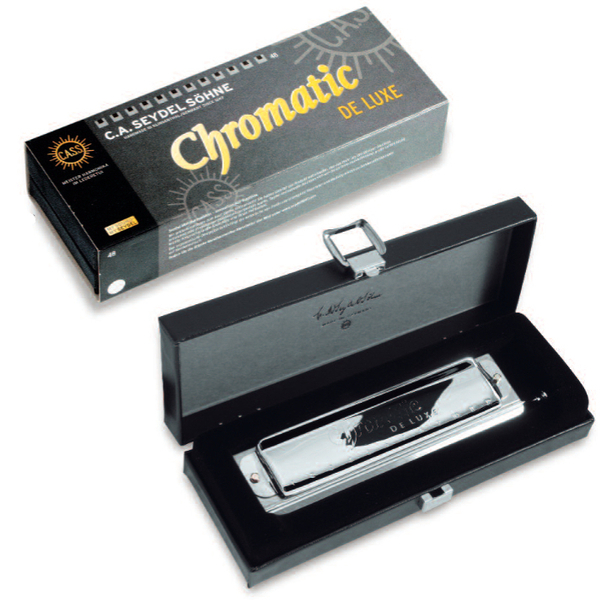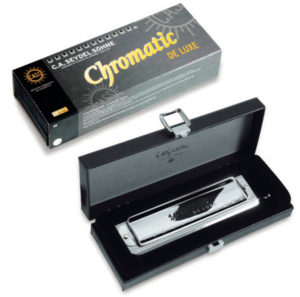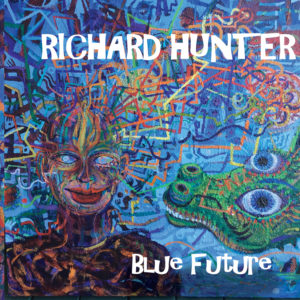
How I Recorded “Vivid”
“Vivid (Hurt and Far)” is the only piece on “The Lucky One” that uses nothing more than reverb and delay on the harmonica, and while there are three harmonica parts on the record, they’re all performed using the same (uneffected) chromatic harmonica in C (a Seydel Deluxe, to be specific–a relatively low-priced, solid performing 3-octave chromatic harp). So how is this 21st Century rock harmonica? Well hey man, you didn’t think we were going to leave chromatic harps behind when we went to the future, didja? Hell no. We need those things whenever we want to make people cry.
“Vivid” is about the pain and beauty in life. The lyrics inform you about the pain; the chromatic harps deliver the beauty. Without the chromatics in the picture, that piece would be sad, sad, sad–vivid, and unhappily so, and without the joy of sheer beauty to leaven the pain.
While we’re at it, take a listen to “Vivid” using the player below. Use the fast forward arrow to take you to “Vivid.” It’s the 8th piece in the set.
The structure of “Vivid”
“Vivid’s” structure is simple. The vast body of the piece consists of the repeating chords D-G-A minor-G; the chorus takes the same rhythm and applies it to the chords D-G-F-A minor, repeated twice. I originally had something much more complex in the chorus sections, but my producer Ed Abbiatti pointed out to me that it didn’t have to be complicated–I didn’t necessarily have to change much to make the chorus work. Keeping that in mind, I rewrote the music in about 20 minutes into the form you hear on this record.
The piece goes to F major for the harmonica solo; one of the things I learned from Bela Bartok is that movement by thirds works very well when you want the changes to be a little unsettling (as opposed to the definitive I-am-here-now feeling you get when the bass moves by a 4th or 5th). There is no V chord per se in this piece; all the A chords are minor, so you get the definitive V-I bass movement without the leading tone that tells you you’re going home. In other words, the structure is simple, but it’s not simplistic.
The piece begins with a single chromatic harmonica playing the signature line of the piece, a simple melody in the key of D. The mode for every D chord in the piece is Mixolydian, a mode in D that works very well on the chromatic harp in C. The harmonica palette expands to include two chromatics on the solo section, and three on the outtro. The rest of the instrumentation is pretty stable from start to finish, so the growing presence of the harmonica is what gives the music its dramatic arc.
How “Vivid” was recorded
As per every piece on “The Lucky One,” the full band–Mike Brenner on lap steel, Mark Schreiber on drums, and John Cunningham on bass–recorded this piece live in the studio while I sang and played rough vocal and harp takes. We overdubbed one of the two chromatics on the solo section in the studio; I did all the other harmonica overdubs in my home studio. Before I recorded the extra harps, I laid down electric piano (via the virtual instrument Lounge Lizard) and organ (via the virtual instrument VB3) in my studio, playing along with the band tracks without the use of MIDI quantization–I didn’t put the tracks on a MIDI timecode grid, I just started playing. Lack of quantization notwithstanding, I recorded MIDI instead of audio, so I was able to correct gross errors in the keyboard tracks before committing them to audio. As it turned out, I played the keyboard parts pretty simply and to the point on every track, and there ended up being not a lot of errors to correct. (Hey, it’s a harmonica record anyway. Keep the keys simple.)

The harmonica overdubs were recorded via an Audix Fireball V into the Digitech RP500 and straight to the board from there, and I bypassed all the FX on the RP for every take. I originally tried one of my clean-amped patches in the studio, but Pete Rydberg, the brilliant engineer for these sessions, told me that the RP was taking too much high end out of the harp, so we bypassed the FX and declared victory.
The duo and trio harmonica parts work beautifully together on this piece, and I’d like to be able to claim that I planned it that way–that I wrote them all out and played them from a score, conscious of every note’s relationship to every other, genius that I am. In reality, I improvised all those parts, one after the other, and it was only by chance that I played them back together and discovered that they weaved in and out of each other’s lines in a very pleasing way. Sometimes it’s better to be lucky than smart. I made a point of playing every part with a full tone, and articulating those scalar lines cleanly throughout. The model for this sound is chamber music, not blues, although there are certainly some blue notes in these lines. The clarity of the articulation is part of the beauty that offsets the pain in the lyrics.
What I did plan out for this piece was the sound of the harps at the end, where two chromatics are playing partial chords (A-D, B-D, C-E, B-D: draw 3-5, draw 4-5, blow 5-6, draw 4-5), supported by an organ playing deep triads, and the third chromatic plays a rising line against them, culminating in a final heartbreakingly beautiful high D. THAT’s vivid. I tried a diatonic in various registers for those chords, but in the end the chromatic was the harp that made it sing.
Performing “Vivid” live
There’s no electronic magic in these harmonica tracks, and they stand apart and above from the band, so the only way to perform this stuff is with at least two, and ideally three, players armed with chromatic harmonicas. I suppose a diatonic player could substitute for one or more of the chromatics, but said diatonic player would have to commit to playing very cleanly and classically, i.e. without much blues in the sound, if any. Said diatonic player would also have to switch harps, or do some fancy overblowing, when the harmony switches to F on the solo section. Did I mention that chromatic harps really work better on this song, at least if you want it to sound the way I made it sound?
If you’ve been following this series of posts on the songs from “The Lucky One,” you’re beginning to catch on to the big idea this record represents: with the range of sounds available to harmonica players in the 21st century, there’s no need any longer to assume that a band needs a maximum of one harp player. Two harmonica players or more can easily configure their sounds so that they add a wide range of colors to any band. Two harmonicas can substitute for an organ, a rhythm guitar, a horn section–it’s all there now, and there’s no reason any longer for the harmonica to be a lonely standout in the midst of all those big electronic instruments. The harmonica IS one of the big electronic instruments now.
Enjoy “Vivid,” and take the opportunity to check out this record again. Hey, maybe even buy a copy! I’m just sayin’.
If you liked that, you’ll like these:
the 21st century blues harmonica manifesto in sound
Get it on Amazon
Get it on iTunes
the rock harmonica masterpiece
Get it on Amazon
Get it on iTunes
Tags In
Related Posts
Leave a Reply
You must be logged in to post a comment.
WHAT’S NEW
Categories
- Audio/Video
- Blog
- Blue Future
- Digitech RP Tricks and Tips
- Discography, CDs, Projects, Info, Notes
- Featured Video
- For the Beginner
- Gallery
- Hunter's Effects
- Hunter's Music
- Huntersounds for Fender Mustang
- Meet the Pros
- More Video
- MPH: Maw/Preston/Hunter
- My Three Big Contributions
- Player's Resources
- Pro Tips & Techniques
- Recommended Artists & Recordings
- Recommended Gear
- Recorded Performances
- Reviews, Interviews, Testimonials
- The Lucky One
- Uncategorized
- Upcoming Performances
- Zoom G3 Tips and Tricks


